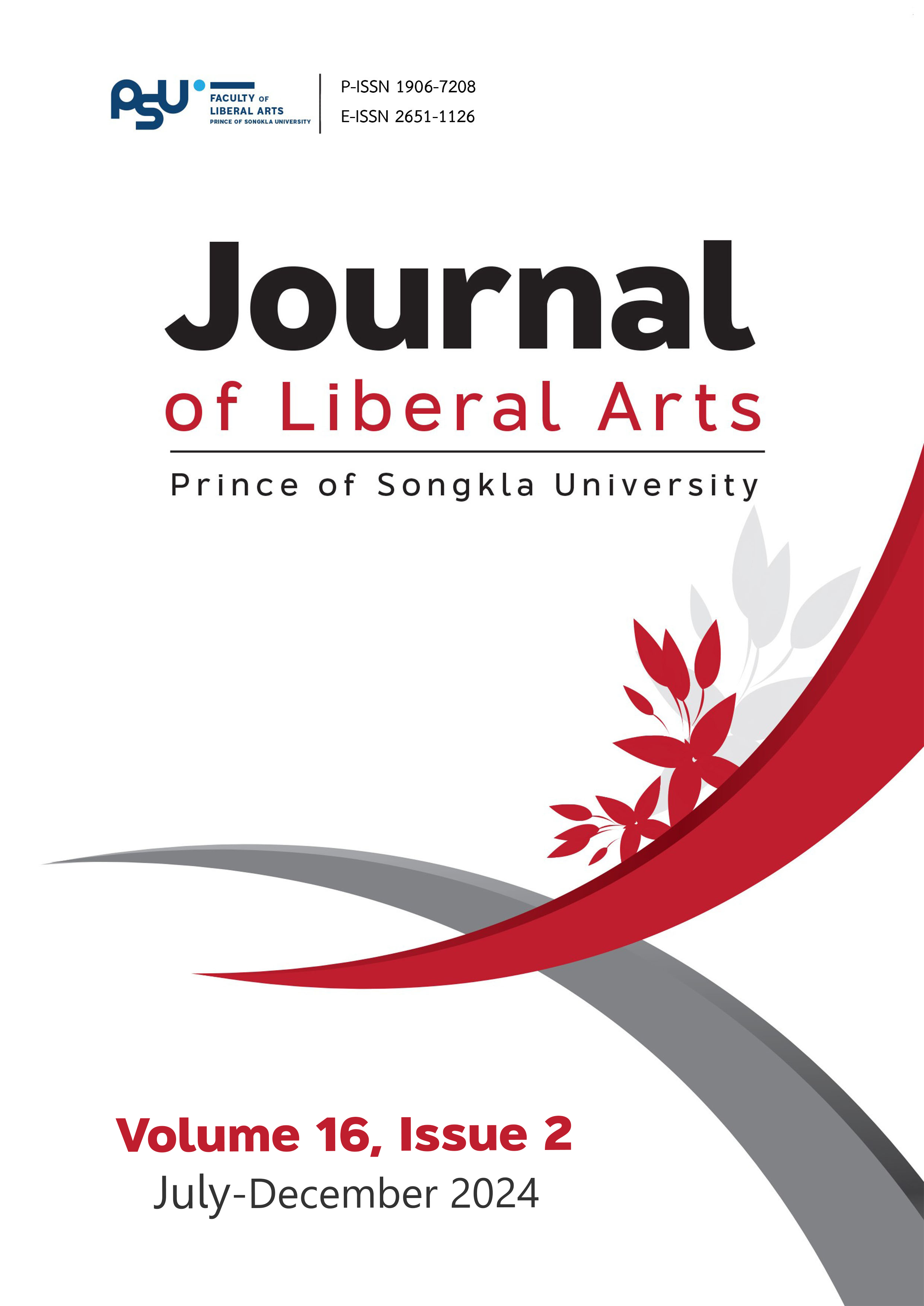ภาพตัวแทนของชุมชนการหาคู่ในประเทศไทย: พื้นที่และอำนาจบนสื่อสังคมออนไลน์
DOI:
https://doi.org/10.14456/jlapsu.2024.12คำสำคัญ:
กลุ่มคนหาคู่ , เฟซบุ๊ก, ภาพตัวแทน , สื่อสังคมออนไลน์ , ประเทศไทยบทคัดย่อ
เครือข่ายสังคมออนไลน์ทำหน้าที่เป็นแพลตฟอร์มเสมือนจริงสำหรับผู้คนในการเชื่อมต่อผ่านเป้าหมายที่มีร่วมกันรวมถึงเป้าหมายในการหาคู่ การศึกษานี้สำรวจรูปแบบการนำเสนอตนเองของบุคคลที่กำลังมองหาคู่รักผ่านเครือข่ายโซเชียลผ่านภาพตัวแทน เพื่อทำความเข้าใจพลวัตทางสังคมและวัฒนธรรมสมัยใหม่ การวิจัยใช้ระเบียบวิธีวิจัยเชิงคุณภาพ โดยวิเคราะห์เนื้อหาจากกลุ่มคนหาคู่บน Facebook ในประเทศไทย โดยเก็บข้อมูลระหว่างเดือนสิงหาคม - ธันวาคม 2566 ใช้แนวคิดภาพตัวแทนและแนวคิดสื่อสังคมออนไลน์เป็นแนวคิดหลักในการวิเคราะห์ ในที่นี้ มีการระบุรูปแบบการนำเสนอตนเอง 6 รูปแบบ ได้แก่ บุคคลในอุดมคติ ภาพที่กระตุ้นความเห็นอกเห็นใจผ่านข้อจำกัดที่รับรู้ ตัวแทนของคนธรรมดาที่ต้องการรักแท้ การแต่งกายและท่าทางที่ยั่วยุ ความหลากหลายทางเพศ และการเป็นตัวแทนข้ามวัฒนธรรม ภาพสะท้อนปรากฏการณ์ทางสังคมผ่านกลุ่มคนหาคู่บนเฟซบุ๊ค พบปรากฏการณ์ 10 รูปแบบ ประกอบด้วย การแสดงออกถึงความหวัง “รักแท้บนโลกออนไลน์” มีอยู่จริง กลุ่มที่ไม่เชื่อว่า “รักแท้บนโลกออนไลน์” มีอยู่จริง ความรักบนผลประโยชน์และการหลอกลวง ความเสมอภาคในโลกเสมือนจริง การสร้างอำนาจและพื้นที่แห่งการต่อรอง พื้นที่แห่งการเฝ้าระวังซึ่งกันและกัน พื้นที่แก้เหงา พื้นที่แลกเปลี่ยน/สร้างกำลังใจ/ตักเตือนแนะนำ ปรากฏการณ์การคุกคามทางเพศและปรากฏการณ์การรู้เท่าทันสื่อ
References
Afolaranmi, A. O. (2020). Social media and marital choices: Its implications on contemporary marriage. IGWEBUIKE: African Journal of Arts and Humanities, 6(4), 130–153. https://acjol.org/index.php/iaajah/article/view/2269
Al-Saggaf, Y., & Nielsen, S. (2014). Self-disclosure on Facebook among female users and its relationship to feelings of loneliness. Computers in Human Behavior, 36, 460-468.
Allen, M. (2012). An education in Facebook. Digital Culture and Education, 4(3), 213-225. https://espace.curtin.edu.au/bitstream/handle/20.500.11937/12096/188547_68537_dce1077_allen_2012.pdf?sequence=2&isAllowed=y
Archer, C., Johnson, A., & Williams, V. L. (2021). Removing the mask: Trust, privacy and self-protection in closed, female-focused Facebook groups. Australian Feminist Studies, 36(107), 26–42. https://doi.org/10.1080/08164649.2021.1969518
Arora, P., & Scheiber, L. (2017). Slumdog romance: Facebook love and digital privacy at the margins. Media, Culture & Society, 39(3), 408 -422. https://doi.org/10.1177/ 0163443717691225
Chaichana, T., Sarikbutr, K, & Janta, R. (2016). Botbat khong phuying saman nai phleng lukthung ruam samai. (In Thai) [Roles of ordinary women in Thai contemporary folksongs]. Genesha Journal, 12(2), 53–62. Retrieved from https://so01.tci-thaijo.org/index.php/ pikanasan/article/view/98997/76977
Chaiharn, S., Kaewkitipong, L., & Kointarangkul, S. (2022). Phonkrathop khong atta lak thang sue sangkhom onlai to atta lak thang wichachip nai yuk dichithan korani sueksa phaet lae phayaban klum che ne re chan wai nai changwat krungthepmahanakhon. (In Thai) [Spillover effects of digital identity for professional identity in digital economy Erathe case of generation Y physicians and nurses in Bangkok]. Journal of Information Systems for Business, 8(1), 35-55. Retrieved from https:// doi: 10.14456/jisb.2022.3
Giannikas, C. (2020). Facebook in tertiary education: The impact of social media in e-Learning. Journal of University Teaching & Learning Practice, 17(1), 2-13. https://ro.uow.edu.au/cgi/viewcontent.cgi?article=1931&context=jutlp
Hall, S. (Ed.). (1997). Representation: Cultural representations and signifying practices (Vol. 2). Sage.
Jitpiriyakan, L. (2019). Ying Mai: Phap Thaen Nang ek Chai Khop Nai Nawaniyai Thai Ruam Samai. (In Thai) [Widows: The Representation of Marginalized Heroines in Contemporary Thai Novels] [Master’s thesis, Mahasarakham University]. https://khoon.msu.ac.th/_dir/fulltext/fulltextman/full4/laongdow12970/titlepage.pdf
Karakiza, M. (2015). The impact of social media in the public sector. Procedia-social and behavioral Sciences, 175, 384-392. https://www.sciencedirect.com/ science/ article/ pii/S1877042815012744
Maghfiroh, V. S., & Muqoddam, F. (2019, January). Dynamics of sexual harassment on social media. In International Conference of Mental Health, Neuroscience, and Cyber-psychology (pp. 154-162). Fakultas Ilmu Pendidikan. https://gci.or.id/assets/papers/ icometh-ncp-2018-272.pdf
Mosquera, R., Odunowo, M., McNamara, T., Guo, X., & Petrie, R. (2020). The economic effects of Facebook. Experimental Economics, 23, 575-602.
Nakaray, P. (2016). Kan prakop sang khwammai phap tuathaen raengngan kham chat Rohingya phan wep sai khao nana prathet. (In Thai) [Social constructed representation of Rohingya immigrants through international website]. Journal of Communication and Innovation NIDA,3(1), 55-75. Retrieved from https://so02.tci-thaijo.org/index.php/jcin/article/ view/69732/56614
Nukulsomprattana, P. (2024). Compilation of Statistics and Key Insights on Thai People's Use of Digital and Social Media in 2024. https://www.popticles.com/insight/thailand-digital-and-social-media-stats-2024/
Phumbandit, C., & Yuadyong,K. (2022). Khwam luang nai sue sangkhom onlai. (In Thai) [Online deception in social media]. Journal of Graduate Studies Valaya Alongkron Rajabhat University, 16(3), 244 – 257. Retrieved from http://grad.vru.ac.th/pdf-journal/JourTs1-16-3
Simon, K. (2024). Digital 2024: Thailand. https://datareportal.com/reports/digital-2024-thailand
Statista. (2023). Social media usage worldwide. https://www.statista.com/statistics/264810/ number -of- monthly -active-facebook-users-worldwide/.
Tasuan, B. (2016). Kan Prakop Sang Khwammai Phuchai Baep Me Tho Sek Chuan Nai Nittayasan Attitude Lae Lips. (In Thai) [ The Construction of Metrosexual Men in Attitude and Lips Magazine] [Master’s thesis, Prince of Songkla University]. https://kb.psu.ac.th/psukb/handle/2016/11593
Thai PBS Digital Media. (2024). A summary of interesting Facebook statistics in the first half of 2023. https://www.thaipbs.or.th/now/content/281
Thepthewin, P. (2015). Kan Chai Sue Sangkhom Onlai Phuea Sadaeng Tua Ton Thang Sangkhom Khong Klom Ke Nai ChangwatChiang Mai Korani Sueksa Facebook Pages. (In Thai) [The Using of Social Media to Present Their Social Identity Among The Gay Groups in Chiang Mai. A Case Study Facebook Pages] [Master’s thesis, Chiang Mai University]. http://cmuir.cmu.ac.th/jspui/handle/6653943832/ 46080
Toland, R. (2013). Facebook as a learning tool. Perspectives In Learning, 14(1). http://csuepress.columbusstate.edu/pil/vol14/iss1/6
Valtysson, B. (2012). Facebook as a digital public sphere: Processes of colonization and emancipation. Journal for a Global Sustainable Information Society, 10(1), 77-91. https://doi.org/10.31269/ triplec.v10i1.312
Veloo, V., & Mustafa, S. E. (2023). Beauty standard in Malaysian advertisements: An analysis from local advertisers’ perspective. SEARCH Journal of Media and Communication Research. 15(2), 1–15. https://fslmjournals.taylors.edu.my/wp-content/uploads/SEARCH/SEARCH-2023-15-2/SEARCH-2023-P1-15-2.pdf
Wilson, R. E., Gosling, S. D., & Graham, L. T. (2012). A Review of Facebook Research in the Social Sciences. Perspectives on Psychological Science, 7(3), 203-220. https://doi.org/10.1177/1745691612442904
Witek, D., & Grettano, T. (2012). Information literacy on Facebook: an analysis. Reference Services Review, 40(2), 242-257. https://www.emerald.com/insight/content/doi/ 10.1108/00907321211228309/full/html?skipTracking=true
Yampochai, K., & Masae, A. (2018). Kan sang baepchamlong khrueakhai thang sangkhom bon fet buk samrap kan chatkan panha dan khwam rak khong phuying. (In Thai) [Building a social network model on the Facebook for women love problem management]. Journal of Social Development, 20(1), 97-118. Retrieved from https://ssed.nida.ac.th/images/jsd/Y20_1/5
Downloads
เผยแพร่แล้ว
How to Cite
ฉบับ
บท
License
Copyright (c) 2024 Areewan Hussadin, Suchanwud Kingkaew

This work is licensed under a Creative Commons Attribution-NonCommercial-NoDerivatives 4.0 International License.
ลิขสิทธิ์บทความเป็นของผู้เขียน แต่วารสารศิลปศาสตร์ มหาวิทยาลัยสงขลานครินทร์ ขอสงวนสิทธิ์ในการเป็นผู้ตีพิมพ์เผยแพร่เป็นครั้งแรก




